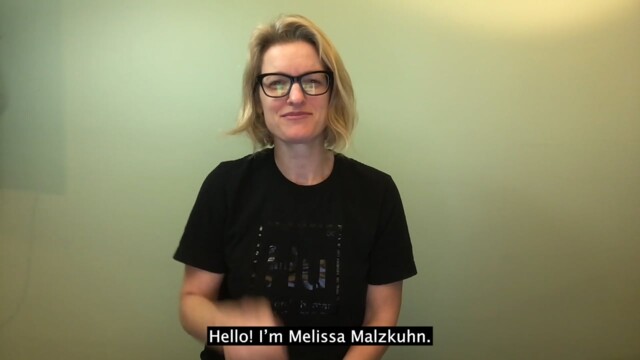"Hu – to sign is human" by Melissa Malzkuhn 2002
This poster, currently hanging on one of the large columns at the entrance to the Schauspielhaus, was designed by American artist and activist Melissa Malzkuhn.
Her campaign Hu - to sign is human aims to raise awareness about the early acquisition of sign languages (1) by Deaf (2) children (especially aged 0 - 5) and calls for equal access to sign languages as a human right.
With her campaign, Melissa Malzkuhn wants to convey the message that Deaf children have the same right to language as everyone, and that it will not be denied to them.
"To sign is human" - this title speaks for itself, because sign languages are a human right for Deaf people. This human right is arbitrarily denied to Deaf communities because of the audistic (3) system.
Sign languages are often dismissed only as a "means of communication" or as an "exception" in special cases and are not offered as a matter of course. No access to the first language results in linguistic deprivation (4). Only early acquisition to sign languages, as well as to any other language, including hearing children, provides Deaf children with the cognitive foundation for the ability to read and write and enables social-emotional bonding. Denying children access to sign languages has devastating consequences and lifelong effects, such as psychological or cognitive problems. Worldwide, only 3% of Deaf children receive sign language instruction.
"Hands behind your back and pursed lips!" - this is what the educational path of many Deaf people looked like. These are the consequences of the Milan Congress of 1880, which was attended almost exclusively by hearing educators, and where the resolution was passed to teach Deaf children only in spoken language ("oral method"). This has spread widely. Sign languages were banned from regular classes and deaf educators were dismissed. Thus, many Deaf students were and still are arbitrarily denied access to education. This has resulted in considerable educational deficits to this day, resulting in high unemployment among Deaf people, among other things.
A quote: "Hearing educators who adhered to the "oral method" did not try to empathize with the abilities and needs of deaf people [...] but forced the former into their own hearing pattern of life". (Rajashekhar 2011: 291)
The year on our poster is 2002: in that year, after a long struggle, German Sign Language (DGS) was finally recognized as an independent language. Unfortunately, this is not enough. Today it is 2023 and the Deaf community is still struggling with the audistic structure of the hearing dominant society. Despite the recognition of DGS as a language, Deaf people are socially handicapped - from infancy to adulthood. With little to no access to education, and even in everyday life (television, government, workplace, public events...), Deaf people are still denied information.
We are still fighting.
(1) Sign languages are written in plural because there is not only "the one sign language", because they differ from country/region to country/region, so it is also important to define which sign language we are talking about, in our case, German Sign Language (DGS).
(2) "Deaf" is always capitalized for reasons of positive self-designation. Hearing is written in lower case, because in contrast to the designation Deaf it is not a political empowering self-designation, but the concrete designation of a privileged positioning. There is also "deaf" as a lowercase word that emphasizes the defect of hearing.
(3) Audism is a mindset of hearing people, for centuries directed against Deaf and hard of hearing people, and based on the phonocentric notion that spoken language and human identity are linked.
(4) Linguistic deprivation: the word deprivation is derived from the Latin verb deprivare ("to deprive") and refers to the "robbing" of a language. Source

By playing the video data is transmitted to Vimeo. Details can be found in the privacy policy.
Hu – to sign is human 2002 – Melissa Malzkuhn | ASL with English subtitles